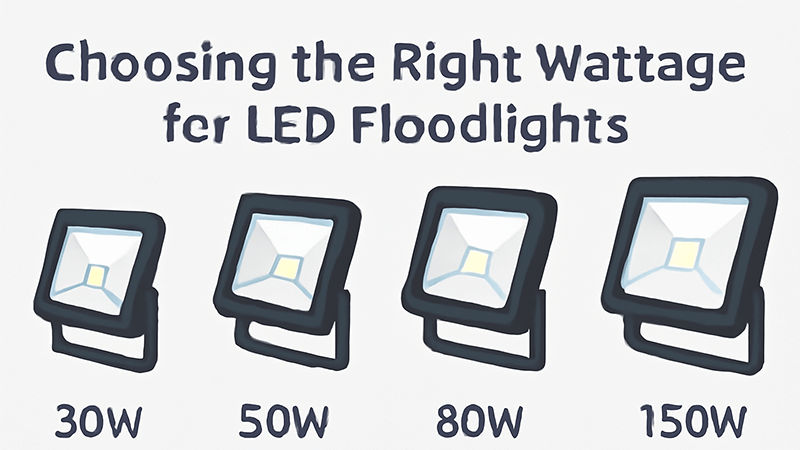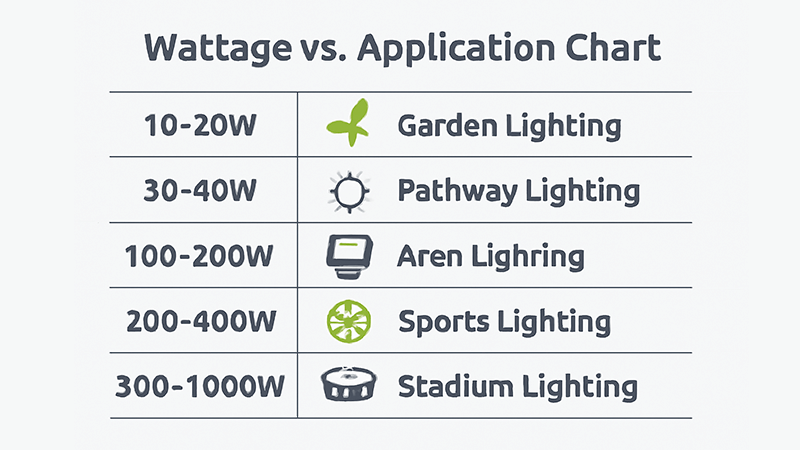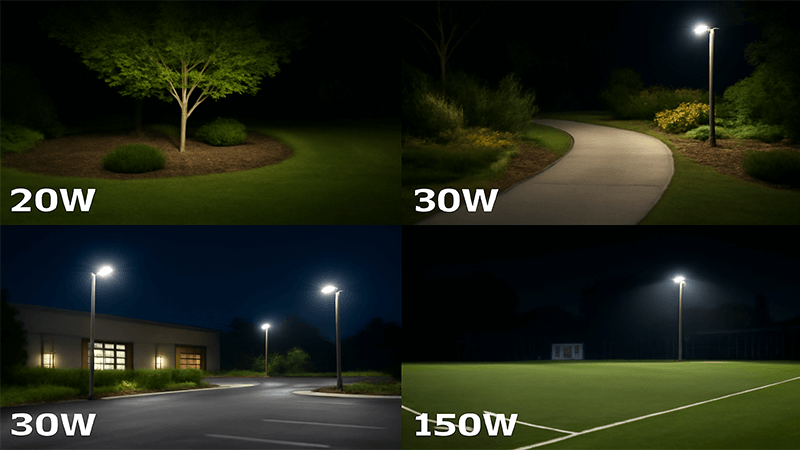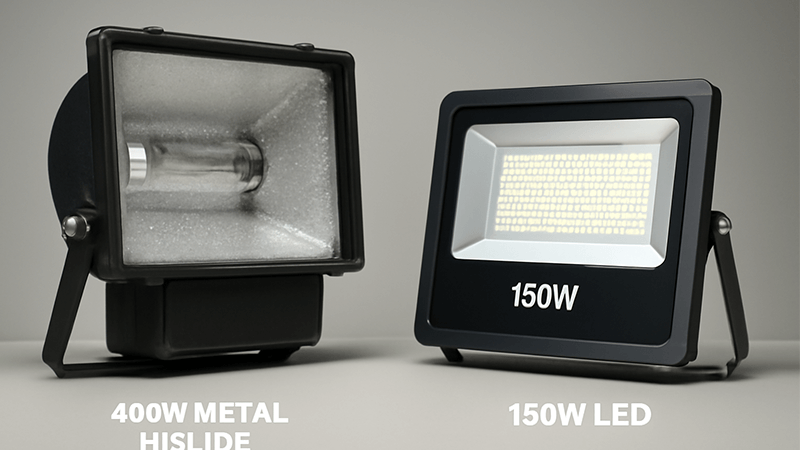Last Updated on: September 1, 2025Choosing the wrong floodlight wattage can be a costly mistake. You might end up with a poorly lit space or an unnecessarily high electricity bill. This guide clarifies everything.
The best way to choose an LED floodlight is to match its brightness (lumens) to your needs, not just its power consumption (wattage). Consider the size of the area you need to illuminate, its purpose, and the mounting height to determine the right lumen output and corresponding wattage.

Getting the wattage right feels like a guessing game. But once you understand that watts simply measure energy use and lumens measure brightness, it all starts to make sense. Too often, I see people buy a floodlight based on wattage alone, only to be disappointed with the result. They either flood a small garden with blinding light or barely illuminate a large parking area. Let’s break down how to make the right choice every time, so you can invest your money wisely and get the exact lighting you need. This is about more than just numbers on a box; it’s about getting the performance and reliability you pay for.
What wattage LED floodlight do I need?
Staring at a shelf of floodlights with different wattages is confusing. Picking the wrong one means your project fails, wasting both time and money. Here’s a simple way to decide.
To find the right wattage, first define your goal. Are you lighting a small pathway or a large commercial yard? For small residential areas, 10W to 30W is usually enough. For larger spaces or security purposes, you might need 50W to 150W or more.

Choosing the right wattage is actually about choosing the right amount of light, which we measure in lumens. Wattage just tells you how much power the light uses to produce that brightness. A higher wattage generally means more lumens, but this is where quality makes a huge difference. In my years in manufacturing, I’ve seen many lights with falsely inflated specifications. A manufacturer might sell a "30W" floodlight that is actually less bright than a high-quality 20W light. They can do this by using less efficient LED chips or by simply lying on the packaging and in fake test reports. Another trick is to label a light as 20W when it actually consumes 25W, misleading you about its energy efficiency. For a purchasing manager like Shaz, it’s critical to look beyond the stated wattage and verify the lumen output and actual power draw from a trusted supplier.
Here’s a general guide to get you started:
| Application |
Recommended Wattage Range |
Typical Lumen Range |
| Small Garden / Pathway |
10W – 20W |
800 – 1,800 lm |
| Driveway / Backyard Security |
20W – 50W |
1,800 – 4,500 lm |
| Building Facade / Small Lot |
50W – 100W |
4,500 – 9,000 lm |
| Large Parking Area / Yard |
100W – 200W |
9,000 – 18,000 lm |
Always start with how bright you need it (lumens), then find a quality fixture with the wattage that delivers it efficiently.
What is the difference between 20W and 30W LED floodlight?
A 10-watt difference seems small, but is it worth the extra cost? Making the wrong choice can lead to a space that’s either too dim or wastefully bright, affecting both safety and budget.
The main difference is brightness and energy use. A 30W LED floodlight typically produces around 50% more light (lumens) than a 20W model from the same product line. This makes it better for illuminating larger areas or for mounting at greater heights where more intense light is needed.

On paper, a 30W light should be significantly brighter than a 20W one. But in the real world, this is where product quality becomes everything. A well-built 20W floodlight from a reputable manufacturer can easily outperform a poorly made 30W unit. I’ve seen this happen countless times. How? It comes down to the components inside. Many low-cost manufacturers cut corners by using regular leaded solder instead of modern, eco-friendly lead-free solder. Leaded solder is less stable at high temperatures and can lead to failed connections, causing the light to flicker or die prematurely. A bigger issue is the thermal management. A 30W fixture generates more heat than a 20W one. To cut costs, some factories use cheap, low-conductivity thermal grease. This grease fails to draw heat away from the LED chips effectively. As a result, the 30W light overheats, its brightness rapidly declines, and its lifespan is drastically shortened. So while you think you’re buying a more powerful light, you’re actually buying a product that will fail faster and provide worse performance over time than a properly engineered, lower-wattage alternative. That’s why I always tell my clients to focus on build quality, not just the wattage printed on the box.
What is the best LED wattage for outdoor lighting?
There is no single "best" wattage for all outdoor lighting. Believing there is will lead you to choose the wrong product for your specific and unique needs, resulting in disappointment.
The "best" wattage is the one that fits your application perfectly. For residential accent lighting, 10-30W is ideal. For commercial security and large area illumination, you should look at fixtures in the 50-200W range to ensure adequate brightness and coverage.

Finding the "best" wattage means correctly matching the light to the task. It’s not about finding one magic number. For a purchasing professional like Shaz, who handles everything from residential projects to large-scale commercial contracts, this principle is key. You wouldn’t use a 150W stadium light to illuminate a garden path, and you can’t expect a 20W light to secure a large warehouse perimeter. The real challenge comes when sourcing for those larger commercial projects. When you need to buy dozens or hundreds of 100W floodlights for a parking lot, relying on wattage alone is a huge risk. This is where I’ve seen many buyers get burned by low-cost suppliers. They are promised a "100W" fixture that seems like a great deal. However, these lights often fail within a year or two because of poor manufacturing quality. The problems I mentioned earlier—like using cheap solder that cracks under thermal stress or low-grade thermal grease that dries out—are magnified in higher-wattage fixtures that generate more heat. A reputable manufacturer, like my company iPHD, focuses on longevity. We use lead-free solder and high-conductivity thermal solutions to ensure our lights perform reliably for years. This focus on quality means our 100W light will maintain its brightness and function long after a cheaper alternative has failed, delivering a much better return on investment.
Matching Wattage to Your Outdoor Space
- Accent and Landscape Lighting: For highlighting trees, architectural features, or garden beds, low wattage is best. 10W to 20W provides a gentle wash of light without being overpowering.
- Security and General Use: For lighting up driveways, backyards, or the side of a building, you need more power. 30W to 50W offers a good balance of brightness and coverage for most residential security needs.
- Commercial and Industrial Areas: For parking lots, building facades, and large yards, high wattage is necessary. 80W to 200W+ fixtures are required to ensure safety and visibility over wide areas.
What is the LED equivalent to a 400W floodlight?
You need to replace an old, power-hungry 400W metal halide light. If you just grab a 400W LED, you will be wasting a huge amount of money on energy you don’t need.
As a rule of thumb, a 400W traditional floodlight (like metal halide or HPS) can be replaced with a 100W to 150W LED floodlight. The key is to compare the lumen output of the old bulb with the new LED fixture, not the wattage.

When I first started in this industry, we spent most of our time replacing old, inefficient technology. A 400W metal halide (MH) floodlight was the standard for bright, large-area lighting. However, these lights waste a tremendous amount of energy as heat. LED technology is far more efficient, meaning it converts a much higher percentage of electricity directly into light. This is why you can achieve the same level of brightness with a much lower wattage. A typical 400W MH bulb produces around 32,000-36,000 initial lumens, but this brightness drops significantly over its life. A high-quality 150W LED floodlight can produce a stable 18,000-22,000 lumens. While that sounds like less, the directed light and better color rendering of the LED often make the area feel just as bright and much safer.
Here’s where you must be careful. I remember a client who tried to save money by buying cheap "100W LED equivalents" from an unknown supplier. The price was fantastic, but the lights were dim and more than half of them failed within 18 months. The supplier advertised a high lumen output but delivered a product with second-rate LED chips and terrible heat dissipation. The internal components, likely assembled with substandard solder and cheap thermal paste, couldn’t handle the heat and quickly degraded. To make a true equivalent replacement, you must ignore the marketing claims and check the technical specifications for two things: Total Lumens (the actual brightness) and Luminous Efficacy (lumens per watt). A quality 150W LED should deliver over 130 lumens per watt. A cheap one might be under 100, meaning it’s not much more efficient than the old tech it’s replacing.
Conclusion
Choosing the right floodlight means looking beyond wattage. Focus on lumens for brightness, consider the application, and most importantly, invest in quality to ensure reliable performance and long-term value.